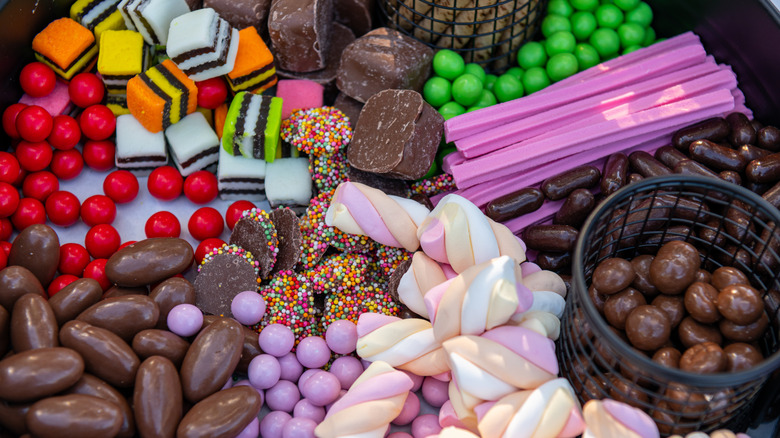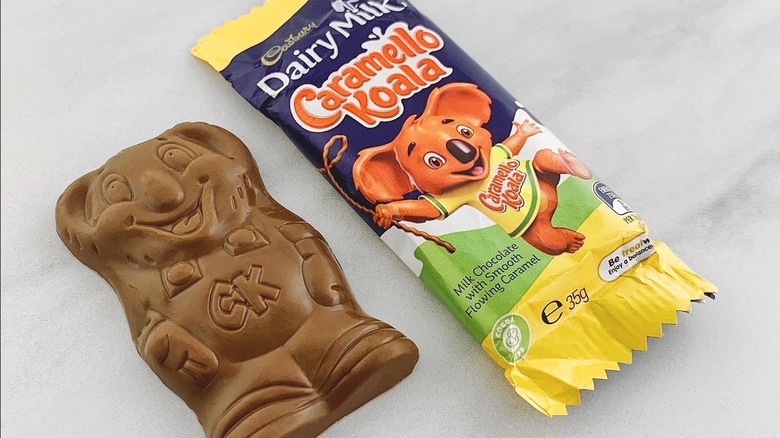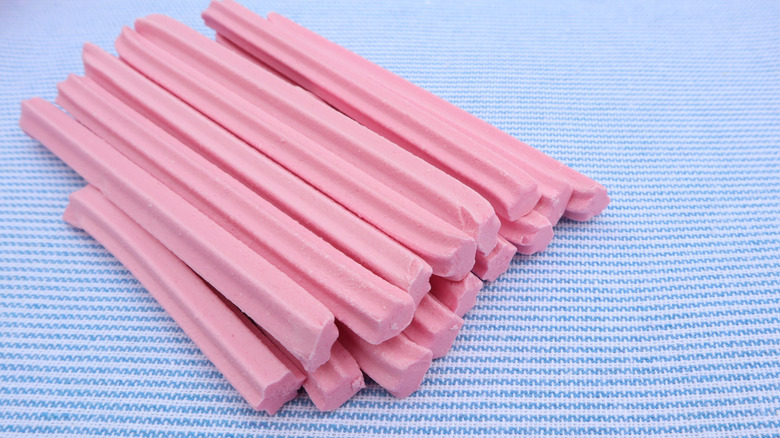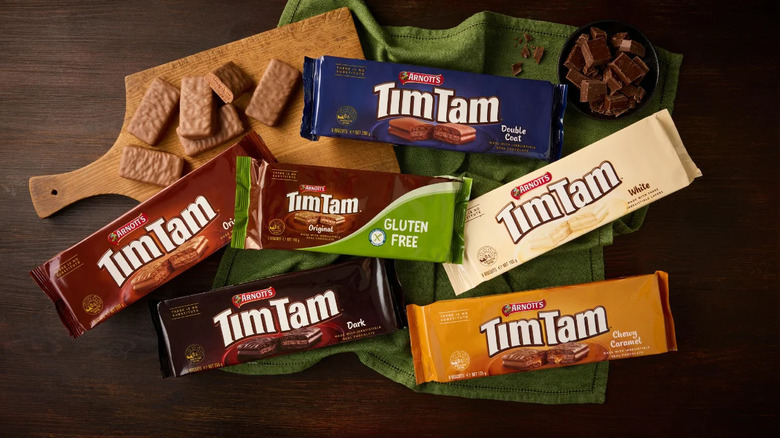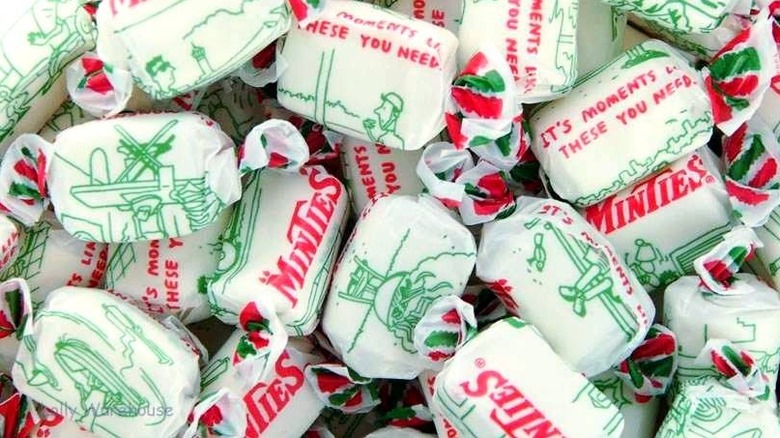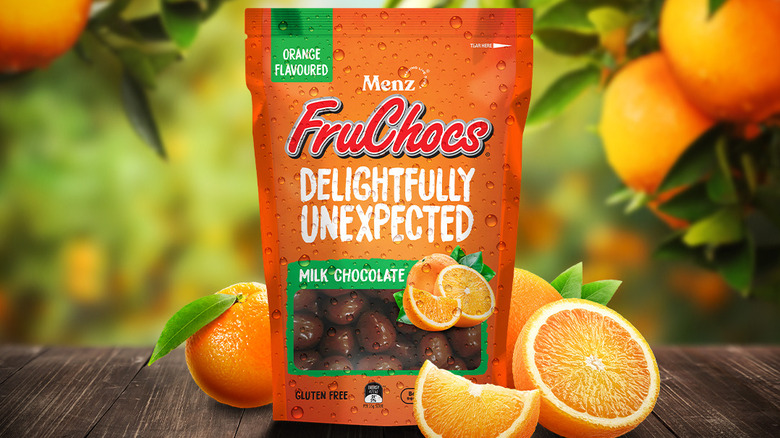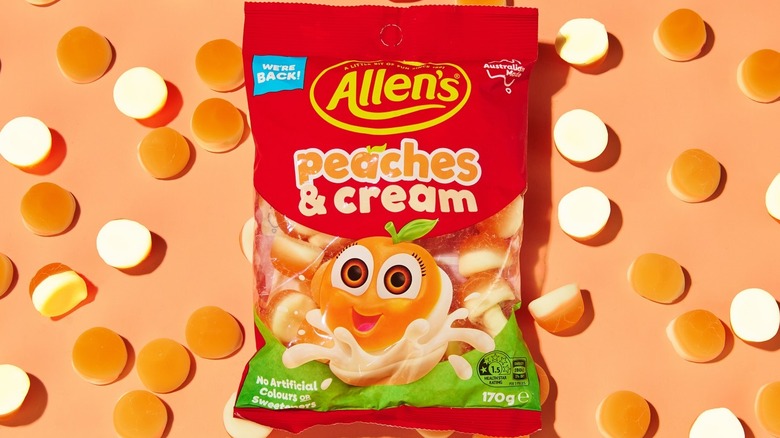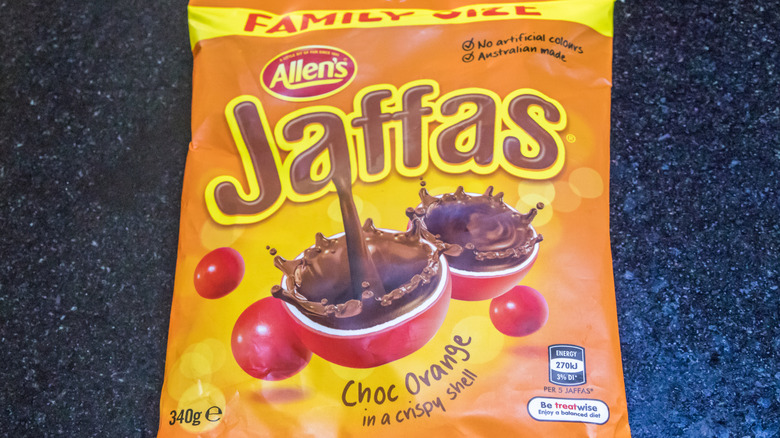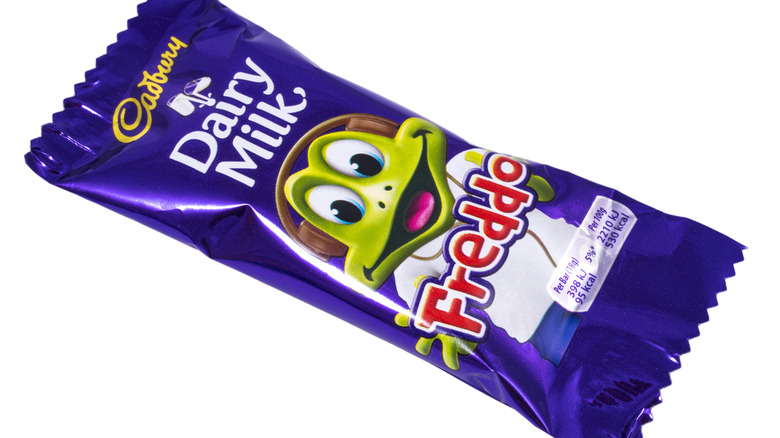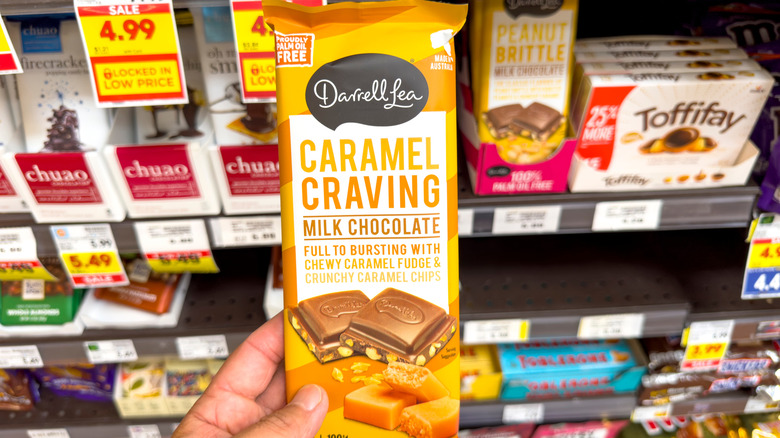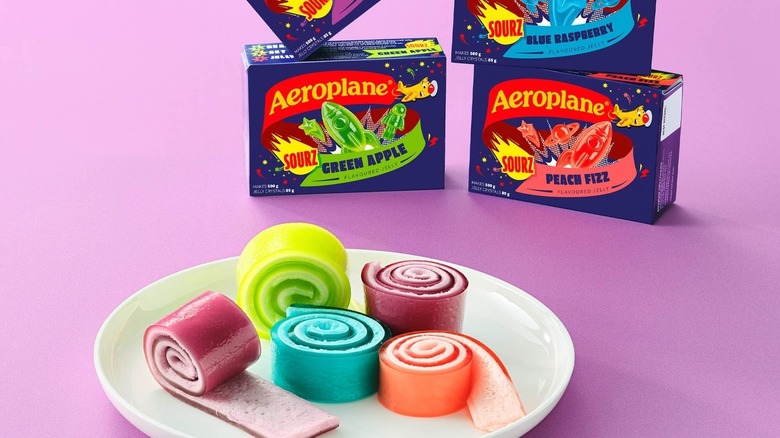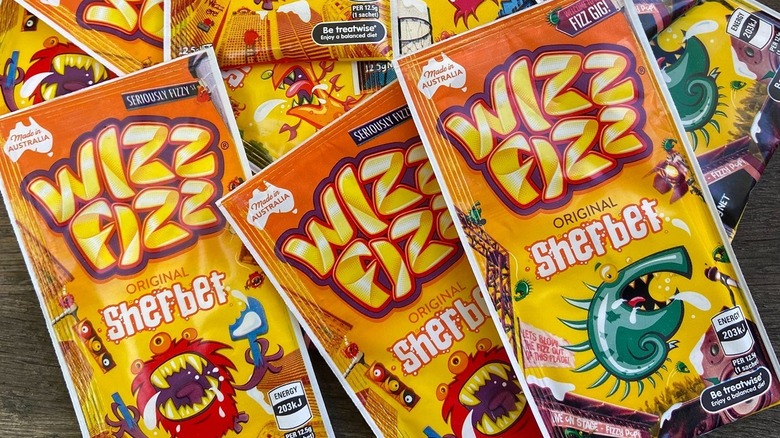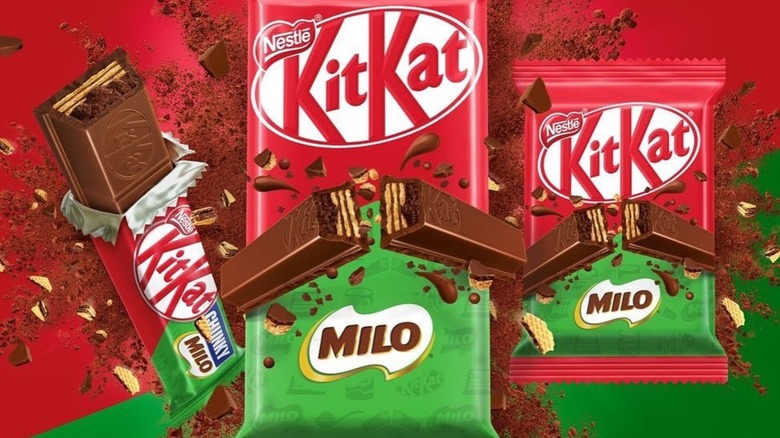14 Australian Candies You Need To Try At Least Once
Australia has a surprisingly strong candy game. Many of the treats are so common over there that locals barely think twice about them. Meanwhile, visitors are busy stuffing their suitcases with extras to take home. You've got chewy fruit candies, oddly named chocolate bars, and things that sound like a joke until you try them (looking at you musk sticks). If you've spent any time in Australia, you've probably come across at least a few of these sweets (or lollies, as they're called there). And if you haven't, it's worth getting familiar with them.
I've been lucky enough to try tons of Australian candies, both during trips to Australia to visit friends and while living in Bali, where Australian tourists and expats were never shy about sharing snacks from home. Whether it was a friend tossing me a Cherry Ripe on a long drive or someone cracking open a bag of Allen's jellies at a beach party, these treats have popped up in my life enough times that I've developed a real soft spot for them. If you're looking for some new sweets to add to your candy drawer, these are 14 Australian candies that are worth trying at least once.
Caramello Koala
You'd be hard-pressed to find an Australian who hasn't crossed paths with a Caramello Koala. Made by Cadbury, this grinning chocolate marsupial is one of the country's most recognizable sweets. It features a milk chocolate shell shaped like a cartoon koala, filled with soft, flowing caramel that's just gooey enough to be fun without being overly messy. It's sold individually in 15-gram and 35-gram sizes and in share packs that are great for filling up lunchboxes or handing out at parties. They're easy to find in just about every supermarket, petrol station, and corner store.
Caramello Koala first hit shelves in the 1960s under the name Caramello Bear. In the 1980s, it got a rebrand and took on its current form and name. It's one of Cadbury's best-known offerings in Australia alongside Freddo Frog (more about that later). Beyond being a lunchbox classic, Caramello Koala has made its way into fundraisers, holiday stockings, and showbags at Royal Shows. Its staying power says a lot. There's something about the combination of nostalgia, cartoonish charm, and that rich caramel center that just works.
Violet Crumble
When you hear the name Violet Crumble, you might picture some sort of lavender-hued and possibly lavender-flavored treat. Actually, this crunchy candy bar features golden honeycomb toffee coated in milk chocolate. It was introduced in 1913, making it Australia's oldest candy bar. Legend has it that Abel Hoadley, the creator, named it after his wife's favorite flower. The company has changed hands several times over the decades but is now back in Australian ownership and made in Adelaide.
The classic Violet Crumble bar is long and rectangular with hard chocolate on the outside and crispy honeycomb in the middle. When you bite into it, it instantly crumbles and gives a satisfying crunch. As the company slogan goes, "It's the way it shatters that matters." If you've ever had a Cadbury Crunchie bar, the sensation is similar. (Side note: The Crunchie bar came out 16 years after Violet Crumble.) You can opt for the OG chocolate bar with milk or dark chocolate or try fun variations like Violet Crumble cubes and nuggets. Around the holidays, you can also pick up mint-flavored Violet Crumble cubes.
Musk sticks
There's no polite way to say it: Musk sticks are weird. But they're weird in a way that some Aussies absolutely adore. These long, powdery pink sticks are slightly soft and chewy. They also taste and smell like perfume. Musk sticks are typically made with gelatine, glucose, and icing sugar. Most importantly, they get their flowery flavor and aroma from musk, a compound that was once derived from the scent glands of animals and often used in perfumes. Today, musk sticks, perfumes, and most other products contain synthetic musk, as musk deers are an endangered species. The taste of musk sticks has been likened to everything from sugary rose water to potpourri and the inside of a grandmother's makeup box.
Musk sticks have their roots in musk lozenges, which were popular in the Middle East and Europe as far back as the 1600s and up to about the 1900s. After that, the perfume-scented sweets fell out of favor in many places, but not in Australia. Although they may seem old-school, a handful of brands continue to sell these nostalgic treats. For instance, Woolworths (an Australian supermarket chain) sells about 24 million musk sticks every year, per ABC News. Still, not everyone's on board — musk sticks recently earned a place in Sweden's Disgusting Food Museum. Love them or hate them, they definitely make an impression.
Tim Tams
If I had to choose my absolute favorite sweet treat from Australia, it would have to be Tim Tams. Technically, Australians consider these biscuits (aka cookies in North America) as opposed to lollies, but I would argue they're also like mini chocolate bars. They feature two crumbly cookies with a layer of velvety cream in the middle, all of which is coated in chocolate. They're rich and indulgent but also surprisingly light, which makes it all too easy to smash your way through all 11 Tim Tams in a package in one sitting.
Tim Tams are made by Arnott's, a snack food company that was founded by a Scottish baker named William Arnott in 1853. The idea for Tim Tams came about when the company's head of food technology encountered Penguin biscuits in England and decided to create something similar. Apparently, Tim Tams were named after a winning horse from the 1958 Kentucky Derby. In 1963, the first Tim Tams hit the market and they were a huge success. The original flavor features chocolate cookies and chocolate cream encased in chocolate, but you can also get a wide range of flavors including mint, white chocolate, and salted caramel brownie.
Minties
Minty, chewy, and sticky, Minties are bite-sized candies wrapped in wax paper that have been around for generations. They were first invented in 1922 by James Noble Stedman, whose father owned a confectionary company. His creation was a white, rectangular mint with a clean peppermint flavor and a taffy-like texture. In 1926, the company started producing cartoons of unfortunate situations with the slogan "It's moments like these you need Minties," and that drew in adults and kids alike. The cartoons are still on the wrappers today.
Now sold under the Allen's brand, Minties have managed to hold onto their place in Australian candy culture for over a century. Part of their charm is the built-in wrapper game, which involves tearing the waxy paper into the longest strip possible without it breaking, a pastime that's kept kids (and bored adults) occupied for decades. But their real staying power lies in their familiarity. They're simple, nostalgic, and just chewy enough to get stuck in your teeth. Just be careful if you have fillings, though, because the candies have been known to cause more than a few trips to the dentist.
FruChocs
FruChocs were officially declared a South Australian icon in 2005, and locals would probably argue it should've happened sooner. These marble-sized balls of chocolate-coated fruit might not look revolutionary, but in the state of South Australia, they're beloved for their tangy fruit cores that balance well with the smooth chocolate shell. You'll find them everywhere in South Australia, from supermarkets to airport gift shops and snack bowls at family barbecues. There's even a FruChocs Appreciation Day held in Adelaide, which pretty much says it all.
The Menz company created FruChocs in 1948 as a way to use up leftover fruit from the region. The original version features peach and apricot covered in milk chocolate, but you can now find a range of flavors, including white chocolate raspberry, milk chocolate strawberry, and milk chocolate orange. There are also giant FruChocs for those who want to go all out. The candies come in resealable bags, which is great if you want to pretend you're going to save some for later. If you're not in South Australia, the candies can be hard to find, but there are select stores that carry them in other states. You can also order them directly from the company online.
Cherry Ripe
Cherry Ripe is one of Australia's oldest chocolate bars, and it still has a loyal following thanks to its unique mix of cherries, coconut, and dark chocolate. First created by MacRobertson's Chocolates in 1924 and now produced by Cadbury, the bar hasn't changed much in the last hundred years. The rich chewy filling gets texture and nuttiness from the coconut and a sweet, tangy fruit profile that leans more toward the taste of jarred cherries versus canned (if you know, you know).
No matter where you go in Australia, there's a good chance you'll be able to find Cherry Ripe bars at supermarkets and corner stores. They're harder to find outside Australia, which makes them a novelty for travelers. Cadbury also sells multiple variations of the chocolate bar. You can try the original 44-gram bar, double up with a twin pack, or try the double dipped bar with extra chocolate. There are also Cherry Ripe minis, share packs, and seasonal treats like the hollow chocolate egg filled with Cherry Ripe pieces.
Allen's Jellies
Allen's is basically the biggest name in Aussie lollies, especially when it comes to party mixes and nostalgic childhood sweets. The company was founded in 1922 by Alfred Weaver Allen in Melbourne and started out selling confections like chewing gum and cough drops. It later expanded into all kinds of sweets like peppermints, caramels, and chocolates. Today, some of its most popular products are the jellies, or gummy candies as they're called in some other parts of the world.
Some of the most iconic Allen's jellies include Snakes Alive, which feature gummy snakes in a range fruit flavors. Ask Aussies what the best flavor is and you'll likely stir up plenty of debate. Then there's the Retro Party Mix, packed with nostalgic favorites like racing cars, teeth, milk bottles, and foam bananas. The Ripe Raspberries, Peaches and Cream, and Strawberries and Cream also get top billing. The jellies are great straight from the bag, of course, but many people also use them to top cakes, fold them into desserts, or transform store-bought ice cream using leftover candy.
Jaffas
If you love the combination of orange and chocolate, Jaffas will be right up your alley. These round candies have a hard red candy shell and are filled with creamy, orange-flavored chocolate. Many Australians have fond memories of sucking on the candy until the shell turned white and their tongues turned a bright shade of red. Older generations reminisce about rolling them down the aisles at movie theaters. The crunchy candies are so beloved that they've inspired a slew of desserts like Jaffa-inspired cupcakes and cakes.
Jaffas were created in 1931 by James Stedman-Henderson's Sweets and they were named after the city of Jaffa in Palestine, which is renowned for its oranges. It's possible the candies were inspired by the Jaffa Cake, an orange-chocolate cake created by McVitie's from England in 1927, though there is no solid evidence to back that up. While the candies are now under the Allen's umbrella, they're becoming increasingly harder to find. In 2023, many stores stopped selling them due to low sales. However, you can still get them at many Cole's grocery stores and some online vendors.
Freddo Frog
Freddo Frog is right up there with Caramello Koala as one of Australia's most iconic and beloved chocolate treats. The candy was conceived in 1930 at the MacRobertson Steam Confectionary in Melbourne, the same place that gave birth to Cherry Ripe. Owner MacPherson Robertson originally wanted to create a chocolate mouse, but an employee pointed out that a frog might be less startling for those afraid of mice. The chocolate frog was an instant hit and became so popular that it even spawned a television cartoon, making Freddo Australia's first animated cartoon character.
Freddo Frog has undergone many makeovers throughout the decades. The first versions looked more like real frogs and were sold without packaging for a penny a piece. After Cadbury took over the company, Freddo morphed into a cartoon-like character and took on its brightly colored packaging. Now, you can get classic milk chocolate Freddo Frogs and a version with a strawberry flavored center. The chocolates are easy to find all over Australia and New Zealand, and they're also sold in the U.K.
Darrell Lea blocks
Walk down the chocolate aisle in a U.S. grocery store and you'll mostly see popular chocolate bars from big-name brands like Hershey's, Cadbury, and Ritter Sport. But tucked among them, you might spot something a little different: Darrell Lea. This Australian company has been making sweet treats since 1927 and now offers everything from licorice to candy balls and chocolate treats in stores across Australia and countries abroad, including the United States. In fact, the U.S. is the company's biggest export market for its famous soft licorice. For many, though, the blocks (aka chocolate bars) are the stars of the lineup thanks to their unique flavors.
If you've never tried a Darrel Lea block before, I recommend you start with the Rocklea Road, which features a dreamy mix of toasted coconut, crunchy peanuts, and marshmallows in milk chocolate. What's more, the Fairy Block is a fun take on whimsical fairy bread with milk chocolate, mini marshmallows, and sprinkles. Other unique flavors include the Milk Chocolate Caramel Cheesecake, Gingerbread Chocolate, and Peppermint Dark Chocolate Whipp. No matter which flavor you grab, you'll be getting a quality bar made with sustainably sourced cocoa, sunflower oil instead of palm oil, and other top-notch ingredients.
Aeroplane Jelly
For many Aussies, Aeroplane Jelly transports them directly back to childhood. This wobbly, fruit-flavored dessert is Australia's answer to Jell-O. It's sold in packets of powdered gelatin that you mix with boiling water and chill until set. The brand dates back to 1927, when a tram driver named Bert Appleroth started selling his homemade jelly crystals door-to-door. By the 1930s, Aeroplane Jelly had become a household name, helped along by its catchy jingle and charming animated ads.
Aeroplane Jelly comes in a wide array of flavors, including classics like strawberry, orange, and lemon, as well as fun flavors like port wine and sour green apple. You can go traditional and make it in bowls or glasses for a quick and easy dessert, or get creative and use it to make no-bake bars, trifles, and jelly roll-ups. You can also use the crystals in cookies, roll frozen grapes in them, or make Jello-shots for an adult treat. However you use it, Aeroplane Jelly is one of those nostalgic staples that's managed to stick around simply because it's just that fun.
Wizz Fizz
Do you like your candy to have a kick to it? Well, Wizz Fizz is a tongue-tingling powder that gives an instant sugar rush. It was created by Arthur and Marjorie Campbell of the Fyna company in the 1940s. The couple built their business making jam, then branched out into confectionaries. Arthur wanted to give the Fyna lollipops a bit more pizazz, so he created a sherbet — not the iced treat that Americans call sherbet, but a sweet candy powder that fizzes up when it comes into contact with water.
The first Wizz Fizz packets were designed to dip lollipops into, but that was rather unwieldy, so Fyna switched to serving the sherbet with spoons for easy eating. Not surprisingly, this messy sugary treat that stains your tongue with bright colors is geared towards kids, so the packaging has always featured fun images like clowns, Disney characters, and wacky monsters. The classic sherbet comes in packs of eight or party boxes with 50 packets. There are also Wizz Fizz marshmallow cones and fizzy fruit pops.
Milo KitKat
Few chocolate bars are as universally loved as KitKat. It debuted in England in 1935 and was an instant hit for its combination of crunchy wafers covered in smooth milk chocolate and its easily breakable design. In the U.S., you don't see too many flavors beyond the classic. That's because the company behind Kitkat in the U.S. is the Hershey Company, but everywhere else, Nestlé produces the bars and allows for interesting flavors like matcha, orange chocolate, and Biscoff. In Australia, the Milo Kitkat is a fan favorite.
Milo is an Aussie invention through and through. It was first developed in Sydney in the 1930s as a malted chocolate drink powder designed to give kids energy and nutrients. Creator Thomas Mayne wanted it to dissolve into liquid, but he couldn't get the formula down. He eventually realized that the crunchy bits left in drinks were part of the product's appeal. Milo is still hugely popular today in Australia and around the world. The Milo KitKat combines the crisp wafer layers of a regular bar with a creamy, malty Milo filling, basically capturing the character of the drink in candy bar form.
